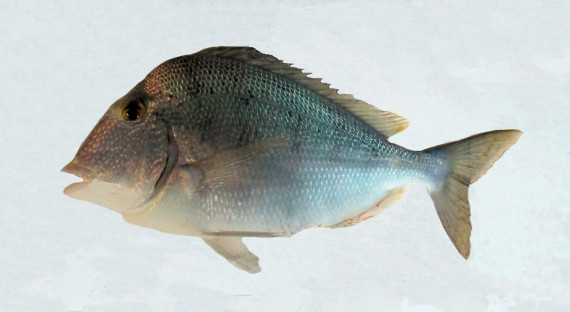Knobbed Porgy, Calamus nodosus
 Knobbed Porgy, Calamus nodosus. Fish caught from the Florida Middle Grounds within the Gulf of Mexico, March 2015. Length: 41 cm (16 inches). Catch, photograph and identification courtesy of George Brinkman, Guelph, Ontario, Canada.
Knobbed Porgy, Calamus nodosus. Fish caught from the Florida Middle Grounds within the Gulf of Mexico, March 2015. Length: 41 cm (16 inches). Catch, photograph and identification courtesy of George Brinkman, Guelph, Ontario, Canada.
 Knobbed Porgy, Calamus nodosus. Fish caught from coastal waters off Cancun, Quintana Roo, August 2013 Length: 30 cm (12 inches). Catch, photograph and identification courtesy of Dominick Porcelli, Lighthouse Point, Florida.
Knobbed Porgy, Calamus nodosus. Fish caught from coastal waters off Cancun, Quintana Roo, August 2013 Length: 30 cm (12 inches). Catch, photograph and identification courtesy of Dominick Porcelli, Lighthouse Point, Florida.
The Knobbed Porgy, Calamus nodosus, is a member of the Porgy or Sparidae Family, and is known in Mexico as mojarrón pecoso. Globally, there are thirteen species in the genus Calamus, of which nine are found in Mexican waters, eight in the Atlantic and one in the Pacific Ocean.
The Knobbed Porgy is characterized by their “porgy-like” laterally compressed relatively deep bodyes, which have a depth that is 46% to 50% of standard length. They have an overall pinkish silvery coloration with a bluish cast. Their snout and cheeks have yellow to bronze spots. They have blue streaks under their eyes and a blue spot at the base of their pectoral fins. Their head is deep with a very steep upper profile, a projecting or humped forehead (in mature adults), and a well-developed bony knob above the rear nostril (after which they are named). They have a large mouth with thick heavy lips. They are equipped with molar teeth on the sides of each jaw and equal-sized canines at the front of each jaw that are used to crush hard shell prey. Their anal fin has a short base with 3 spines and 10 or 11 rays; their caudal fin is forked; their dorsal fin is low with 12 or 13 spines and 11 to 13 rays; and their pectoral fins are long and reach past the anal fin origin. Their body is covered with scales.
The Knobbed Porgy is a common coastal species and are abundant throughout most of their range; they are found over hard bottoms, within ledges and caves, within coral reefs and associated gravel, and in grass and sand areas along the outer continental shelf at depths up to 300 feet. They reach a maximum length of 54 cm (21 inches), but on average measure around 35 cm (14 inches) and can weigh up to 2.6 kg (5 lbs 11 oz). As of January 1, 2024, the International Game Fish Association world record stood at 2.63 kg (5 lbs 12 oz) with the fish caught in coastal waters off Texas in February 2000. They are bottom dwellers that feed primarily on invertebrates including barnacles, crabs, mollusks, polychaetes, sea stars, and sea urchins. They are protogynous hermaphrodites with all fish starting out as females and changing to males at midlife. Each female releases thousands of eggs which are fertilized externally by males and become pelagic. They are generally long-lived (up to 17 years) and are slow growing.
The Knobbed Porgy is a resident of all Mexican waters of the Atlantic Ocean being found throughout the Gulf of Mexico with the exception that they are absent from along the east coast of the Yucatán Peninsula in the Caribbean.
The Knobbed Porgy is very similar in shape to the seven other Porgies found in Mexican waters of the Atlantic Ocean, however, it is the only one with numerous small spots on its face.
From a conservation perspective the Knobbed Porgy is currently considered to be of Least Concern with stable, widely distributed populations. They are considered to be an excellent food fish and are targeted by both commercial and recreational fishermen utilizing hook and line, longlines, bottom trawls and fish traps. They are caught alongside other reef fish, such as the Gray Triggerfish, Red Porgy, Atlantic Red Snapper, and Red Porgy. They are unregulated in most parts of their range (except for coastal waters of the southeast United States) and commercial landings have declined as well as fish body length significantly in the last ten years. They are subject to habitat destruction and overfishing in some parts of their range.